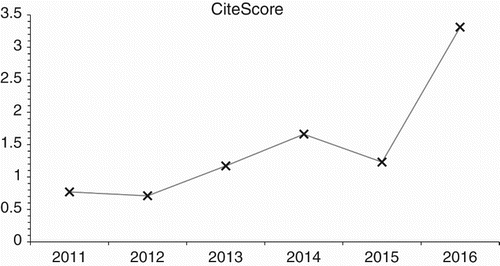Back in 2006, Virtual and Physical Prototyping was established as a peer reviewed journal to focus on the field of rapid prototyping. A decade later, the journal has grown in strength and primed itself for the blooming field of what is now known as additive manufacturing (AM) or 3D printing. Since April 2016, the journal is indexed in Emerging Sources Citation Index (ESCI) by Clarivate Analytics, which was formerly known as Thomson Reuters. With the launch of Emerging Sources Citation Index Ten Year Archive programme, most of the articles published in this journal will become visible in Web of Science by end of the year. Currently, 18 articles from 2017, 34 articles from 2016 and 25 articles from 2017 have been archived in Web of Science. From these 77 articles, a total of 387 citations are recorded. Using the CiteScore from Scopus, the journal has also done very well in achieving the highest ever CiteScore of 3.31 for 2016 (available on 23 May 2017). CiteScore is calculated from the average citations received in the year to the documents published three years prior ().
The CiteScore has also ranked Virtual and Physical Prototyping as one of the top-tiered journals in Modelling and Simulation, Industrial and Manufacturing Engineering and Computer Graphics and Computer Aided Design ().
Table 1. Subject areas ranking for VPP.
In this year alone, the journal has published 27 research articles with wide range of topics, from performance evaluation of material jetting 3D printing (Yang et al. Citation2017), design approaches in AM (Al-Tamimi et al. Citation2017) to algorithm conversion for AM files generation (Shulunov Citation2017, Shulunov and Esheeva Citation2017). Two special issues on 3D printing of electronics and 4D printing were also published. These trends well reflect the ever-growing industrial applications of AM and continued interest by the academia. In this last issue of the year, five articles are included. Liu et al. did an review on cell encapsulation and 3D bioprinting for organ regeneration (Liu et al. Citation2017). Leist et al. investigated the shape memory properties of polylactic acid in 4D printing for smart textiles (Leist et al. Citation2017). Lu and Wong provided a comprehensive review on the challenges and potentials of using non-destructive testing methods for AM process control and monitoring (Lu and Wong Citation2017). Santos et al. designed and developed a customised knee positioning orthosis using low cost 3D printers (Santos et al. Citation2017). Last but not least, Tran recommended a new book on standards for AM and 3D printing (Tran Citation2017). This is the first published textbook dedicated to the topic of standards, quality control and measurement sciences in AM (Chua et al. Citation2017).
As the fruitful and fulfilling 2017 ends, it is also a great opportunity to look forward to the future. The third International Conference on Progress in Additive Manufacturing (Pro-AM 2018) will be held in Singapore from 15–17 May 2018. This biennial conference and exhibition will showcase the latest commercial and scientific progress in AM. Experts and researchers world-wide are invited to share their latest breakthrough in various topics related to AM, such as:
Materials
Measurement science and methods
Software and data processing
Applications and industries
Design
Equipment and new techniques
References
- Al-Tamimi, A.A., et al., 2017. Metallic bone fixation implants: a novel design approach for reducing the stress shielding phenomenon. Virtual and Physical Prototyping, 12 (2), 141–151. doi: 10.1080/17452759.2017.1307769
- Chua, C.K., C.H. Wong, and W.Y. Yeong, 2017. Standards, quality control, and measurement sciences in 3D printing and additive manufacturing. Elsevier.
- Leist, S.K., et al., 2017. Investigating the shape memory properties of 4D printed polylactic acid (PLA) and the concept of 4D printing onto nylon fabrics for the creation of smart textiles. Virtual and Physical Prototyping, 12 (4).
- Liu, H., et al., 2017. Organ regeneration: integration application of cell encapsulation and 3D bioprinting. Virtual and Physical Prototyping, 12 (4).
- Lu, Q.Y. and C.H. Wong, 2017. Applications of non-destructive testing techniques for post-process control of additively manufactured parts. Virtual and Physical Prototyping, 12 (4).
- Santos, S., et al., 2017. Design and development of a customised knee positioning orthosis using low cost 3D printers. Virtual and Physical Prototyping, 12 (4).
- Shulunov, V., 2017. Comparison of algorithms for converting 3D objects into rolls, using a spiral coordinate system. Virtual and Physical Prototyping, 12 (3), 249–260. doi: 10.1080/17452759.2017.1325132
- Shulunov, V. and I. Esheeva, 2017. A Linear algorithm for conformal 3D-to-flatness coordinates conversion. Virtual and Physical Prototyping, 12 (1), 85–94. doi: 10.1080/17452759.2016.1276820
- Tran, T., 2017. On the bottleneck of adopting 3D printing in manufacturing. Virtual and Physical Prototyping, 12 (4).
- Yang, H., et al., 2017. Performance evaluation of ProJet multi-material jetting 3D printer. Virtual and Physical Prototyping, 12 (1), 95–103. doi: 10.1080/17452759.2016.1242915

